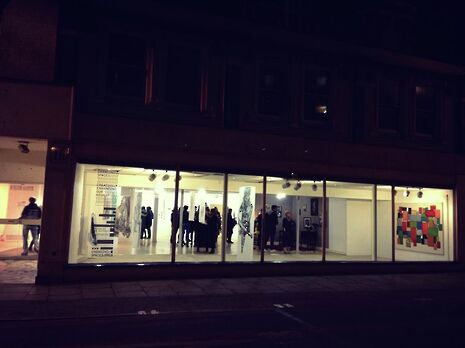Art: sub.ti.tled
Robert Hawkins reviews the new Changing Spaces exhibition put on by the Christ’s Visual Arts Scholars
Artistic collectives are interesting things. Running through a few of the more notable examples from the last hundred years, one quickly realises that there's a common theme – or rather, a common theme of common themes. Artists tend to live together, work together and exhibit together when they've got something in common: think of the shared aesthetic and philosophy of the Bloomsbury set, or the symbiosis of the St Ives school. Picasso and Braque did not work together for three years for the sake of economy or mutual convenience - they did so for their art, creating a melting pot of shared and overlapping concerns.

This week, though, Changing Spaces on King Street is playing host to a 'collective' of a different sort – one formed through administrative necessity. The Christ's Visual Arts Scholars are a ragtag bunch of undergraduates, who, as well as reading for their degrees, make work in the studio space above the gallery, and exhibit together. I asked curator Anji Main if assembling a show with a disparate group of artists was challenging. “It's an unusual form of curating. I see what works together […] how the pieces talk to each other.” This is, to an extent, successful. After spending some time in the immaculately presented space, however, I start to wonder if this 'talking' is anything more than superficial chatter. The pieces complement each other visually; nothing conflicts – but there's no profound dialogue between separate contributions. And why should there be? These artists pursue their own work, independent of each other. “For lots of them, this is their first show. I think they've done an amazing job.”
This, then, is a Footlights-Smoker-esque exhibition of snappy, disparate segments from often inexperienced but always enthusiastic participants. An audience member will recall moments of total entertainment interspersed with the occasional damp squib: the exhibition's visitors, I expect, will remember the same. Rosa Johan-Uddoh's characterful series of portraits is one such moment of total success: drawing and painting on tracing paper, her energetic, charged lines are ecstatic against their luminous background. Paint, heavily diluted with medium, puddles and pools, complementing the draughtsmanship: this is Maggi Hambling-esque, and very assured.
The most exciting pieces for me were in this vein: honest, and uncomplicated by conceptual baggage. Melina Jeurgens' enigmatic photography is visually very sophisticated and glamorous, but I became distracted by the domestic installation surrounding it, torn between reading it as an interior design showroom and taking the visual cue offered by the prominent sewing machine towards something more Dada-inspired. Either way, these are exciting photographs in danger of being confused by their ambitious presentation. Anne-Claire Morel showed me round the show; we talked about her contribution Almighty Me, which, for her, is all about process – what clay led her to do; what casting then led to: finishing with an elaborate conceptual gloss.
Just as with a Smoker, some stand-out successes turned out (on further investigation) to be the work of older, more experienced hands. Issam Kourbaj, artist in residence at Christ's, has the significant advantage of a career's worth of experience. Whilst his Rauschenberg-like Farewell, My City of Joy felt somewhat derivative, I was thrilled by Move-less, a free-standing sculpture in the main gallery space. Witty and contradictory, this assemblage of wooden parts rejoices in irony: dowels are divorced from their sockets, left impotent and alone, while a wheel/steering column arrangement (hinting at movement) is silenced by the prominent screws fixing the creation to the floor. A chair leg hovers above a grooved socket that will never accept its advances.
This show benefits from its inherent disjointedness. “There are lots of people at Cambridge who are passionate about making art but have chosen to come here; they're really keen to carry on that aspect of their life, and that feeds into their overall development and holistic outlook”. Of course, the difference between making art at Cambridge and making it in an art school is the lacking sense of immersion, of constant criticism and subsequent improvement. Thus, the exhibition feels a little bit like a 'crit': a plethora of fresh ideas, and a wealth of experimentation and exploration. The invitation to critique, to comment, to form opinions on the work and to try to articulate them – this invitation is open to us all, and the experience is rewarding.
'sub.ti.tled' runs 22nd - 24th February at 6-16 Gallery, King Street
 News / News in Brief: Postgrad accom, prestigious prizes, and public support for policies11 January 2026
News / News in Brief: Postgrad accom, prestigious prizes, and public support for policies11 January 2026 Comment / Will the town and gown divide ever truly be resolved?12 January 2026
Comment / Will the town and gown divide ever truly be resolved?12 January 2026 Comment / Plastic pubs: the problem with Cambridge alehouses 5 January 2026
Comment / Plastic pubs: the problem with Cambridge alehouses 5 January 2026 Lifestyle / The only party girl in the East Midlands12 January 2026
Lifestyle / The only party girl in the East Midlands12 January 2026 News / 20 vet organisations sign letter backing Cam vet course13 January 2026
News / 20 vet organisations sign letter backing Cam vet course13 January 2026








